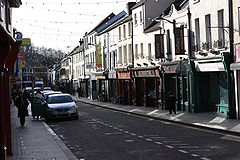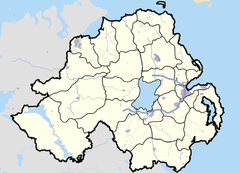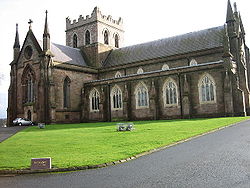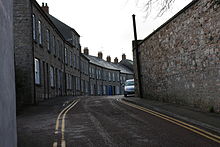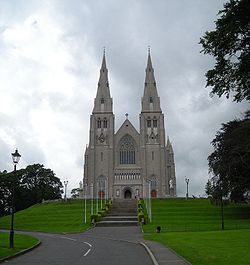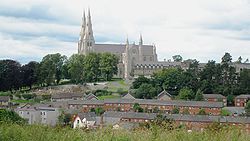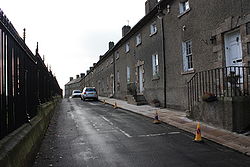- Armagh
-
Coordinates: 54°21′00″N 6°39′17″W / 54.3499°N 6.6546°W
Armagh Scots: Airmagh[1] or Armagh[2] Irish: Ard Mhacha
Thomas Street
 Armagh shown within Northern Ireland
Armagh shown within Northern IrelandPopulation 14,590 (2001 Census) Irish grid reference H876455 - Belfast 33 miles District Armagh Country Northern Ireland Sovereign state United Kingdom Post town ARMAGH Postcode district BT60, BT61 Dialling code 028 Police Northern Ireland Fire Northern Ireland Ambulance Northern Ireland EU Parliament Northern Ireland UK Parliament Newry & Armagh NI Assembly Newry & Armagh Website [1] List of places: UK • Northern Ireland • Armagh (
 /ɑrˈmɑː/ ar-mah; from Irish: Ard Mhacha meaning "Macha's height") is a large settlement in Northern Ireland, and the county town of County Armagh. It is a site of historical importance for both Celtic paganism and Christianity and is the seat, for both the Roman Catholic Church and the Church of Ireland, of the Archbishop of Armagh. In 1995, Armagh city was twinned with Razgrad, Bulgaria.
/ɑrˈmɑː/ ar-mah; from Irish: Ard Mhacha meaning "Macha's height") is a large settlement in Northern Ireland, and the county town of County Armagh. It is a site of historical importance for both Celtic paganism and Christianity and is the seat, for both the Roman Catholic Church and the Church of Ireland, of the Archbishop of Armagh. In 1995, Armagh city was twinned with Razgrad, Bulgaria.Although classed as a medium-sized town,[3] Armagh was granted city status by Queen Elizabeth II in 1994. Its population of 14,590 (2001 Census) makes it the least-populated city in both Northern Ireland and on the island of Ireland and the fourth smallest in the United Kingdom.
Contents
History
Foundation
Eamhain Mhacha (or Navan Fort) at the city's edge, is believed to have been used as an ancient pagan ritual or ceremonial site. According to Irish mythology it was once the capital of Ulster, until it was abandoned during the 1st century. The site was named after the goddess Macha, and as the settlement grew on the hills nearby, it was also named after the goddess — Ard Mhacha means "Macha's height". This name was later anglicised as Ardmagh,[4][5] which eventually became Armagh.
When Christianity spread to Ireland during the mid-400s, Armagh became the island's "ecclesiastical capital", as Saint Patrick established his principal church there. Saint Patrick decreed that only those educated in Armagh could spread the gospel. According to the Annals of the Four Masters, in the year 457:
Ard Mhacha was founded by Saint Patrick, it having been granted to him by Daire, son of Finnchadh, son of Eoghan, son of Niallan. Twelve men were appointed by him for building the town. He ordered them, in the first place, to erect an archbishop's city there, and a church for monks, for nuns, and for the other orders in general, for he perceived that it would be the head and chief of the churches of Ireland in general.
Medieval era
In 839 and 869, the monastery in Armagh was raided by Vikings. As with similar raids, their objective was simply to acquire valuables such as silver, which the churches and monasteries often kept.
The Book of Armagh came from the monastery. It is a 9th century Irish manuscript now held by the Library of Trinity College, Dublin (ms 52). It contains some of the oldest surviving specimens of Old Irish.
Brian Boru is believed to be buried in the cemetery of the St. Patrick's Church of Ireland cathedral. After having conquered the island during the 990s, he became High King of Ireland in 1002, until his death in 1014.
In 1189, John de Courcy, a Norman knight who had invaded Ulster in 1177, plundered Armagh.[6]
Modern era
Armagh has been an educational centre since the time of Saint Patrick, and thus it has been referred to as "the city of saints and scholars". The educational tradition continued with the foundation of the Royal School in 1608 and the Armagh Observatory in 1790. This was part of the Archbishop's plan to have a university founded in the city. This ambition was finally fulfilled, albeit briefly, in the 1990s when Queen's University of Belfast opened an outreach centre in the former hospital building.
Three brothers from Armagh died at the Battle of the Somme during World War I. None of the three has a known grave and all are commemorated on the Thiepval Memorial to the Missing of the Somme. A fourth brother was wounded in the same attack.
On 14 January 1921, during the Irish War of Independence, a Royal Irish Constabulary (RIC) sergeant was assassinated by the Irish Republican Army (IRA) in Armagh. He was attacked with a grenade as he walked along Market Street and later died of his wounds.[7] On 4 September 1921, Michael Collins and Eoin O'Duffy addressed a large meeting in Armagh, which was attended by up to 10,000 people.[8]
The Troubles
2001 Census
The population of Armagh City on Census day (29 April 2001) was 14,590 people, of whom:
- 25.1% were aged under 16 years;
- 17.5% were aged 60 and over;
- 48.1% were male and 51.9% were female;
- 68.3% were from a Catholic community background;
- 30.2% were from a Protestant or other Christian community background;
- 11.6% were born outside Northern Ireland; and
- 1.0% were from an ethnic group other than white.
The average age was 35.2 years (NI average age 35.8 years). For more details see: NI Neighbourhood Information Service
Climate
Armagh has, like most of Ireland, a temperate maritime climate (Cfb) according to the Koppen climate classification system. The nearest Met Office standard weather station, at Armagh Observatory, provides long term weather data back to 1844. During that time, the highest temperature to be recorded was 30.3 °C (86.5 °F) on the 10th July 1934.[9] The lowest temperature was −15.1 °C (4.8 °F) on the 7th February 1895.[10]
Typically, the warmest day of the year will reach 26.1 °C (79.0 °F)[11], and 3.7 days a year should attain a maximum temperature of 25.1 °C (77.2 °F) or above.[12]
Typically the coldest night of the year should fall to −6.8 °C (19.8 °F)[13] and 40.4 nights should register an air frost.[14] All averages refer to the 1971-2000 observation period.
Climate data for Armagh Weather Observing Station 1971-2000, extremes 1844- Month Jan Feb Mar Apr May Jun Jul Aug Sep Oct Nov Dec Year Record high °C (°F) 14.7
(58.5)15.9
(60.6)21.7
(71.1)22.6
(72.7)26.2
(79.2)30.0
(86.0)30.3
(86.5)29.4
(84.9)26.7
(80.1)21.7
(71.1)16.8
(62.2)15.0
(59.0)30.3
(86.5)Average high °C (°F) 7
(45)7.6
(45.7)9.7
(49.5)12.2
(54.0)15.2
(59.4)17.7
(63.9)19.6
(67.3)19.2
(66.6)16.6
(61.9)13
(55)9.5
(49.1)7.6
(45.7)12.9
(55.2)Average low °C (°F) 1.7
(35.1)1.7
(35.1)2.9
(37.2)4
(39)6.3
(43.3)9.1
(48.4)11.4
(52.5)11
(52)9
(48)6.7
(44.1)3.5
(38.3)2.4
(36.3)5.81
(42.45)Record low °C (°F) −14.3
(6.3)−15.1
(4.8)−12.4
(9.7)−7.1
(19.2)−2.3
(27.9)0.8
(33.4)1.7
(35.1)2.3
(36.1)−0.6
(30.9)−5.6
(21.9)−8.3
(17.1)−14.6
(5.7)−15.1
(4.8)Rainfall mm (inches) 79.8
(3.142)57.5
(2.264)64.9
(2.555)55.4
(2.181)54.4
(2.142)55.7
(2.193)52.3
(2.059)71.9
(2.831)67.1
(2.642)81.1
(3.193)72.1
(2.839)83.4
(3.283)795.6
(31.323)Sunshine hours 44 61.9 89.3 133.2 165.2 141.6 134.9 133 110.7 86.5 57 34.4 1,191.7 Source: [15] Notable buildings
Armagh is the site of two cathedrals, both on hills and both named after Saint Patrick. The Church of Ireland cathedral dates back to around 445. The present-day, post-Reformation, Roman Catholic cathedral was constructed during the latter half of the 1800s and features twin 64m spires, making it the tallest such structure in the county. Armagh is the only city in the world which is home to two cathedrals of the same name.
Armagh has a Georgian area of heritage importance. Perhaps one of the more well known of the buildings is the former women's prison.[16] The construction of Armagh Gaol began in 1780 and was extended in the 1840s and 1850s; the front facade of the prison being built in the Georgian style, while the later development, based on the design of Pentonville (HM Prison), is Victorian.[16] For most of its working life it was a women's prison although not exclusively so. Armagh Gaol was the primary women's prison in the north of Ireland. In 1986 the prison closed and its prisoners were transferred to the new prison at Maghaberry (HM Prison).[16]
The city is home to the Armagh Observatory, founded in 1790, and to the Armagh Planetarium, established in 1968 to complement the research work of the Observatory. The palace of the Archbishop of Armagh is now the local council offices and, along with the archbishop's private chapel, is open to the public. The Palace Stables heritage centre is a reconstructed stable block dating from the 1700s, which was once part of the Archbishop's estate.
Among the city's chief glories is the public library on Abbey Street. Founded in 1771 by Archbishop Richard Robinson (later Lord Rokeby), using his own library as its nucleus, it is especially rich in 17th and 18th century English books, including Dean Jonathan Swift's own copy of the first edition of his Gulliver's Travels with his manuscript corrections.
Armagh Market House was built in 1815 as a two-storey five-bay building, and is currently used as a library.
City centre regeneration
To combat the problem of a diminishing city centre and to address the concerns of local people, Armagh City and District Council decided to upgrade the surfaces and general appearance of the main shopping areas.
The scheme aims to deal with the many issues raised by the public and businesses over recent years. It will regenerate the centre of Armagh, transforming it into a high-quality pedestrian-friendly environment. The ineffective pedestrian area in Market Street will be opened officially to vehicles. The scheme will provide wider footpaths, pedestrian crossings and disabled parking throughout the city centre to improve safety and accessibility.
As well as these new street layouts the appearance of the city centre will be enhanced by new lighting, paving, seating, bins and greenery. The use of quality stone materials, public art projects and feature lighting will contribute to the overall effect and present the city’s famous architecture at its best. A shop frontage scheme will be launched toward the end of the street development project.
The scheme includes eleven streets: Market Street, Thomas Street, Ogle Street, Scotch Street, Dobbin Street, Dobbin Street Lane, Barrack Street, McCrum's Court, Upper English Street, Russell Street, Ogle Street and Linenhall Street.
The £5m Armagh City Centre Regeneration Scheme is funded by Armagh City and District Council, the Department for Social Development, the Roads Service and the Arts Council of Northern Ireland.
Administration
The city is run by Armagh City and District Council, headquartered in Armagh, which covers a larger area than just the city, but not the entire county. Together with part of the district of Newry and Mourne, it forms the Newry & Armagh constituency for elections to the Westminster Parliament and Northern Ireland Assembly. The Member of Parliament is Conor Murphy of Sinn Féin, who is a former Provisional Irish Republican Army prisoner and a member of the Sinn Féin negotiations team. He won the seat in the United Kingdom general election, 2005, after the retirement of long-serving SDLP MP Seamus Mallon.
The Southern Education and Library Board and the Southern Health and Social Services Board have their headquarters in the city, which has a long reputation as an administrative centre.
The secretariat of the North/South Ministerial Council is based in Armagh, and consists jointly of members of the civil services of both Northern Ireland and the Republic of Ireland.
Armagh is the seat of both the Church of Ireland Archbishop of Armagh and the Roman Catholic Archbishop of Armagh, both of whom hold the position of Primate of All Ireland for their respective denominations.
Education
Primary
- Armstrong Primary School
- Christian Brothers Primary School Armagh
- The Drelincourt Primary School
- Dromintee Primary School
- Drumhillery Primary School
- Mount St Catherine's Primary School
- Saints and Scholars Integrated Primary School
- St. Malachy's Primary School
- St. Patrick's Primary School
Post-primary
- City of Armagh High School
- The Royal School, Armagh
- St. Brigid's High School
- St. Patrick's Grammar School, Armagh
- St. Catherine's College, Armagh
- Southern Regional College[17]
Transport
The Ulster Railway linked Armagh with Belfast in 1848 and Monaghan in 1858.[18] The Newry and Armagh Railway (N&A) opened in 1864 and the Castleblaney, Keady and Armagh Railway (CK&A) was completed in 1910.[18] In 1876 the Ulster Railway became part of the new Great Northern Railway (GNR), which took over the N&A in 1879 and the CKA in 1911.[19]
The Armagh rail disaster, which killed 80 people, occurred on 12 June 1889 on the N&A line near Armagh.[20]
The partition of Ireland in 1922 hastened the railways' decline, and the GNR closed the Keady – Castleblayney section of the CKA in 1923.[21] The GNR withdrew passenger trains from the Armagh – Keady section of the CKA in 1922 and closed the Armagh – Markethill section of the N&A in 1933.[21] The Government of Northern Ireland forced the GNR Board close all remaining lines serving Armagh railway station on 1 October 1957: the goods branch from Armagh to Keady and the main line through Armagh from Portadown as far as the border at Glaslough on the way to Monaghan.[21][22]
Sport
Armagh City Football Club is the local association football club, and the City of Armagh Rugby Club is the local rugby club. Gaelic football is represented by Armagh Harps and Pearse Ógs. The local GAA handball club is Eugene Quinn's, named after a player from the Armagh area who died on an attempted swim from Tory Island to the coast of Donegal. The local hurling club is Armagh Cúchulainns.
In 2004 the Royal School, Armagh became only the second team in history to win both the schools' rugby and hockey cups in the same year.
The Mall in Armagh has a long association with cricket, and is the location of the Armagh Cricket Club clubhouse.
Townlands
Armagh is within the civil parish of Armagh. Like the rest of Ireland, this parish has long been divided into townlands, whose names mostly come from the Irish language. Over time, more townlands have been built upon and they have lent their names to many streets, roads and housing estates.
In 1830, most of Armagh's urban townlands were amalgamated (for administration) and became known as Corporation Lands or simply Corporation.[23] However, the surrounding townlands remained as separate units and they were eventually built upon too. They are listed below alongside their likely etymologies.[4][24]
- Aghamoat (from Irish: Achadh Mochta meaning "Mochta's field")
- Ballynahone Beg (from Baile [Beag] na hAbhann meaning "[small] townland of the river") - part of Lisnadill parish
- Ballynahone More (from Baile [Mór] na hAbhann meaning "[large] townland of the river")
- Cargagh (from Cairgeach meaning "rocky land")
- Cavanacaw (from Cabhán na Cáithe meaning "hollow of the chaff")
- Drumadd (from Druim-fhad meaning "long ridge")
- Drumarg (from Druim Arg meaning "ridge of the chests" or Druim Fhairig meaning "ridge of the feasting/hospitality")
- Drumman More (from an Drumainn meaning "the ridge")
- Killuney (from Cill Lughna meaning "Lughna's church")
- Legarhill or Mullaghcreevie (from Mullach Craoibhe meaning "hilltop of the branch")
- Lurgyvallen (from Lorg Uí Mhealláin meaning "Ó Mhealláin's track")
- Mullynure (from Mullach an Iubhair meaning "hilltop of the yew") - part of Grange parish
- Parkmore (from Páirc Mhór meaning "great field")
- Tullyelmer (from Tulaigh Giolla Mura meaning "Giolla Mura’s mound")
- Umgola (origin uncertain but probably includes the element -gabhla meaning "forks")
See also
- Book of Armagh
- List of towns in Northern Ireland
- List of villages in Northern Ireland
- Market houses in Northern Ireland
References
- ^ Ulster-Scots guide to Moira Station – Department of the Environment
- ^ North-South Ministerial Council: 2010 Annual Report in Ulster Scots
- ^ Northern Ireland Neighbourhood Information Service
- ^ a b Placenames Database of Ireland (see archival records)
- ^ Hill, George. The Fall of Irish Chiefs and Clans; The Conquest of Ireland. Irish Roots Cafe, 2004. p.114.
- ^ DeBreffny, D & Mott, G (1976). The Churches and Abbeys of Ireland. London: Thames & Hudson. pp. 60–61.
- ^ Dublin City University. Chronology of Irish History 1919 - 1923: January 1921
- ^ Dublin City University. Chronology of Irish History 1919 - 1923: September 1921
- ^ "Daily Maximum Temperatures". http://climate.arm.ac.uk/calibrated/airtemp/tccmax1844-2004. Retrieved 2011-09-22.
- ^ "Daily Minimum Temperatures". http://climate.arm.ac.uk/calibrated/airtemp/tccmin1844-2004. Retrieved 2011-09-22.
- ^ "Annual average warmest day". http://eca.knmi.nl/utils/calcdetail.php?seasonid=0&periodid=1971-2000&indexid=TXx&stationid=271. Retrieved 2011-09-22.
- ^ ">25c days". http://eca.knmi.nl/utils/calcdetail.php?seasonid=0&periodid=1971-2000&indexid=SU&stationid=271. Retrieved 2011-09-22.
- ^ ">Annual average coldest night". http://eca.knmi.nl/utils/calcdetail.php?seasonid=0&periodid=1971-2000&indexid=TNn&stationid=271. Retrieved 2011-09-22.
- ^ ">Annual average frost incidence". http://eca.knmi.nl/utils/calcdetail.php?seasonid=0&periodid=1971-2000&indexid=FD&stationid=271. Retrieved 2011-09-22.
- ^ Met Office Armagh 1971–2000 averages
- ^ a b c Three Gaols: Images of Crumlin Road, Long Kesh and Armagh Prisons; Author: Robert Kerr. Publisher: MSF Press, [2011] ISBN 9780956806901
- ^ Armagh College of Further and Higher Education
- ^ a b Hajducki, S. Maxwell (1974). A Railway Atlas of Ireland. Newton Abbott: David & Charles. map 8. ISBN 0 7153 5167 2.
- ^ Hajducki, op. cit., page xiii
- ^ McCutcheon, Alan (1969). Ireland. Railway History in Pictures. 1. Newton Abbott: David & Charles. pp. 104, 105. ISBN 0 7153 4651 2.
- ^ a b c Hajducki, op. cit., map 39
- ^ Baker, Michael H.C. (1972). Irish Railways since 1916. London: Ian Allan. pp. 153, 207. ISBN 7110 0282 7.
- ^ Ulster Place-name Society: Illustrations of townlands in maps
- ^ Placenames NI
External links
Cities in Ireland Republic of Ireland Northern Ireland - not an administrative city
Cities of the United Kingdom England Bath · Birmingham · Bradford · Brighton and Hove · Bristol · Cambridge · Canterbury · Carlisle · Chester · Chichester · Coventry · Derby · Durham · Ely · Exeter · Gloucester · Hereford · Kingston upon Hull · Lancaster · Leeds · Leicester · Lichfield · Lincoln · Liverpool · London · Manchester · Newcastle upon Tyne · Norwich · Nottingham · Oxford · Peterborough · Plymouth · Portsmouth · Preston · Ripon · St Albans · Salford · Salisbury · Sheffield · Southampton · Stoke-on-Trent · Sunderland · Truro · Wakefield · Wells · Westminster · Winchester · Wolverhampton · Worcester · York
Scotland Wales Northern Ireland Categories:- Towns in County Armagh
- Armagh (city)
- County towns in Northern Ireland
Wikimedia Foundation. 2010.

